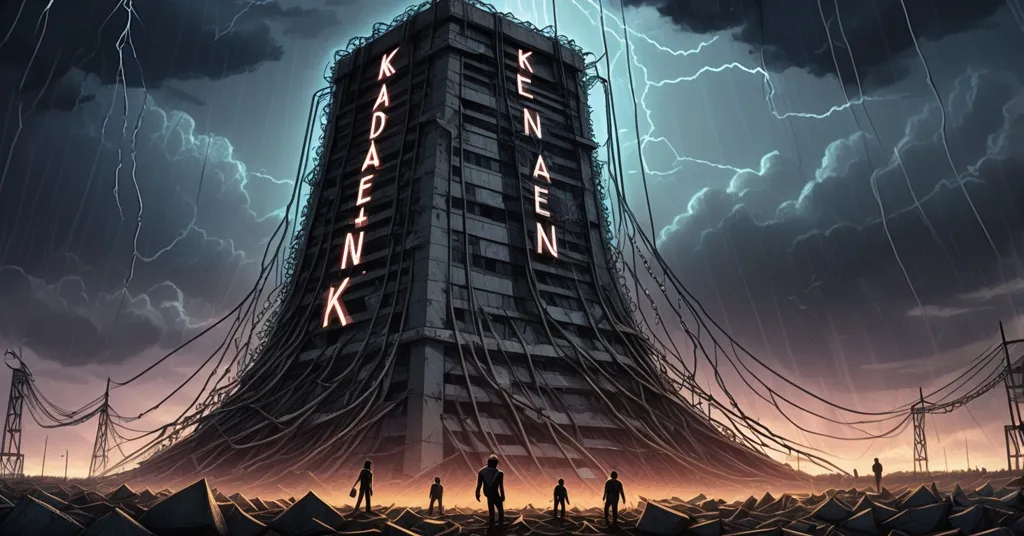Kadena Collapses Under Market Pressure: Blockchain Endures Despite 60% Token Crash

Kadena Shuts Down Amid Brutal Crypto Market: Blockchain Survives
Once a hopeful contender in the blockchain race, Kadena—a proof-of-work smart contract platform founded by ex-JPMorgan insiders—has officially thrown in the towel, citing relentless market conditions as the final blow. While the organization behind Kadena is packing up, the decentralized network trudges on, sustained by independent miners and developers, even as its native KDA token takes a devastating 60% nosedive.
- Closure Bombshell: Kadena organization halts all business operations and active blockchain maintenance.
- Token Bloodbath: KDA price crashes over 60% to $0.089, down 99% from its 2021 high of $27.64.
- Network Endurance: Decentralized Kadena blockchain persists under independent miners and on-chain governance.
Kadena’s Shutdown: The Announcement That Shook Holders
On Tuesday, the Kadena team dropped a gut-punch via an X post, confirming the end of their journey as a business entity.
“We regret to announce that the Kadena organization is no longer able to continue business operations and will be ceasing all business activity and active maintenance of the Kadena blockchain immediately.”
This stark admission underscores the harsh realities faced by smaller blockchain projects in a landscape ruled by titans like Bitcoin and Ethereum. Survival in this space demands not just innovation, but unwavering adoption and financial muscle—resources Kadena evidently couldn’t muster amidst a punishing crypto bear market, as detailed in reports about Kadena’s closure due to tough market conditions.
From Wall Street to Wipeout: Kadena’s Ambitious Origins
Kadena burst onto the scene with its mainnet launch in January 2020, helmed by Stuart Popejoy and William Martino, both veterans of JPMorgan’s early blockchain experiments. Marketed as a “blockchain for business,” Kadena sought to marry the security of Bitcoin’s proof-of-work (PoW) model—where miners solve complex puzzles to validate transactions and secure the network—with the smart contract capabilities of Ethereum, enabling programmable, self-executing agreements on the blockchain. Their unique Chainweb architecture, a braided PoW design meant to boost scalability by running multiple chains in parallel, promised to solve the throughput bottlenecks plaguing older networks. Yet, despite the technical flair, Kadena failed to draw the developer interest or user base needed to compete.
Why the flop? For one, their business-centric focus may have alienated the retail investor crowd that fuels much of crypto’s hype and liquidity. Unlike Ethereum, which boasts a sprawling ecosystem of decentralized apps (dApps) and decentralized finance (DeFi) protocols, or Solana with its high-speed, low-cost transactions, Kadena struggled to showcase real-world use cases or major partnerships. GitHub activity—a rough gauge of developer engagement—remained tepid compared to peers, signaling a lack of coding momentum. Truth is, even the most innovative tech can gather dust if no one’s building on it.
Token in Freefall: Unpacking KDA’s Market Massacre
The shutdown news sent shockwaves through Kadena’s market, with the KDA token price plummeting over 60% to a measly $0.089, according to CoinGecko data. That’s a staggering 99% collapse from its all-time high of $27.64 during the 2021 bull mania—a time when speculative fever inflated countless altcoins to unsustainable heights. To put this altcoin market crash into perspective, Kadena’s 24-hour trading volume sits at a pitiful $48 million, dwarfed by Bitcoin’s $95.6 billion and Ethereum’s $42.9 billion. Even a fleeting spike of interest during a micro altseason in December 2024, marking KDA’s highest monthly volume since Q2 2022, couldn’t stem the bleeding.
At its peak in early 2022, Kadena’s Total Value Locked (TVL)—the amount of assets staked or locked in its protocols—reached a modest $9 million. Some starry-eyed projections pegged its Fully Diluted Valuation (FDV), a metric estimating a token’s worth if all possible tokens were in circulation, at a lofty $6.5 billion. Let’s cut the nonsense: those figures were more wishful thinking than reality, and the market has delivered a harsh verdict through cratering prices and fading interest. Bagholders are left nursing wounds, a reminder of the brutal risks tied to altcoin investments in a volatile crypto space.
Decentralization’s Last Stand: Can the Network Survive?
Amid the wreckage, there’s a flicker of hope for decentralization diehards. The Kadena blockchain itself isn’t vanishing, thanks to its PoW design and the independent miners who continue to validate transactions and produce blocks. Unlike centralized projects that implode when the parent company folds, Kadena’s on-chain governance—a system where network decisions are made directly by participants through code and community consensus—ensures no single overlord can pull the plug. The team reinforced this resilience, promising support for the transition.
“Developers will shortly provide a new binary that ensures uninterrupted operation without our involvement, and will be encouraging all node operators to upgrade as soon as possible.”
But let’s play devil’s advocate: is a blockchain without active development or corporate backing just a zombie network limping toward obscurity, or a true testament to crypto’s core principles? Bitcoin itself thrives without a central entity, its hashrate and community forming an unassailable fortress. Kadena, however, faces risks—low miner participation could slash network security, leaving it vulnerable to attacks like 51% takeovers, where a malicious actor controls the majority of computing power. With no organization steering the ship, the community’s grit will be tested. Can Kadena’s ragtag band of miners and developers breathe life into this orphaned chain, or will it fade into the altcoin graveyard?
Failed Gambits: Kadena’s Desperate Push for Adoption
Kadena didn’t go down without a fight. In 2022, they unveiled a $100 million grant program aimed at enticing Web3 developers to build on their platform, followed by a $50 million Leap Grant Program hyped by Stuart Popejoy on The Defiant Podcast. They also secured $15 million across three funding rounds and planned a hiring blitz in 2024 to claw back market share. Sounds impressive on paper, right? Except the results were a dud. Details on how much of these funds reached developers are murky, and the lure evidently paled next to Ethereum’s battle-tested ecosystem or Solana’s vibrant DeFi scene, both of which have long dominated coder interest with robust grants and user bases.
Here’s the harsh reality: throwing cash at developers doesn’t guarantee loyalty if the underlying platform lacks network effects or clear incentives. Kadena’s grants may have been misaligned—perhaps too focused on niche business use cases while ignoring the retail-driven DeFi and NFT crazes that fueled competitor growth during the 2021 boom. Without killer dApps or a buzzing community, no amount of money could bridge the adoption gap. It’s a bitter lesson for any blockchain project dreaming of relevance in a cutthroat market.
Altcoin Graveyard: What Kadena’s Fall Means for Crypto Innovation
Kadena’s collapse isn’t an isolated sob story; it’s a snapshot of the broader altcoin struggle in 2024. The crypto bear market of 2022, following the euphoric highs of 2021, crushed countless layer-1 chains and tokens that overpromised and underdelivered. Projects hyped as “Ethereum killers” or “Bitcoin alternatives” often wither under the shadow of the big two, whose network effects—liquidity, developer activity, community momentum—create a near-impenetrable moat. Kadena’s plight mirrors this trend, joining a long list of crypto project failures that couldn’t sustain hype once the speculative bubble burst.
From a Bitcoin maximalist lens, this is just natural selection at work. Bitcoin’s unassailable dominance as a store of value and decentralized money sets a benchmark few can match, and perhaps shouldn’t even try. Yet, there’s a counterargument: altcoins, even the fallen ones, play a vital role in pushing boundaries. Kadena’s Chainweb experiment, while a commercial flop, added to the collective knowledge of scaling PoW networks. Ethereum’s smart contract revolution started as a fringe idea too. The question lingers—how much room does crypto have for experimentation before it’s just noise drowning out the signal of true disruption?
Why Should You Care About Kadena’s Collapse?
For newcomers to the crypto space, Kadena’s downfall might seem like distant drama, but it carries real weight. Altcoin failures erode trust in the broader market, spooking potential investors wary of scams or dead-end projects. They also highlight the importance of digging into a project’s fundamentals—team track record, tech viability, adoption metrics—before tossing in your hard-earned cash. If you’re holding KDA or eyeing other underdog tokens, Kadena’s 99% plunge is a screaming reminder: high risk doesn’t always mean high reward. For seasoned players, it’s another data point in the ongoing debate over Bitcoin’s primacy versus the chaotic innovation of altcoins.
Key Takeaways and Burning Questions on Kadena’s Shutdown
- What forced the Kadena organization to shut down?
Relentless market conditions, compounded by failure to drive meaningful adoption or sustain business operations, pushed Kadena to cease all activity. - Will the Kadena blockchain keep running despite the closure?
Yes, as a decentralized proof-of-work network, it continues to operate under the control of independent miners and on-chain governance, independent of the defunct organization. - How badly did the shutdown hit the KDA token?
The price tanked over 60% to $0.089 almost overnight, marking a brutal 99% loss from its 2021 peak of $27.64, per CoinGecko data. - What steps did Kadena take to boost its platform before collapsing?
They launched a $100 million grant program for Web3 developers, a $50 million Leap Grant Program, and raised $15 million in funding, but these efforts fell flat against fierce competition. - How does Kadena’s market presence compare to Bitcoin and Ethereum?
It’s barely a blip—KDA’s $48 million trading volume is peanuts next to Bitcoin’s $95.6 billion and Ethereum’s $42.9 billion, highlighting its struggle for relevance. - Is Kadena’s decentralized survival a win for crypto, or a hollow victory?
It’s a mixed bag—while it showcases blockchain resilience without central control, low miner activity or lack of development could turn it into a ghost chain, raising questions about long-term viability.
Kadena’s fall stings, but it’s a raw reminder that crypto’s frontier thrives on failure as much as success. Each broken chain, each shattered token, pushes us a step closer to a decentralized future—whether through hard lessons or sparks of innovation that refuse to die. Bitcoin’s towering presence looms as the gold standard, yet even in Kadena’s ashes, the stubborn persistence of its network whispers of possibilities. Who knows? Maybe a determined community can turn this ghost ship into a vessel worth sailing. Stranger miracles have happened in this wild, unforgiving space.



